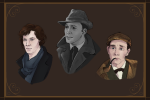At least for me, nothing can surpass watching a murder mystery show straight out of the 20th century. Moody, intricately crafted crimes unfold in softly pixelated 4-to-3 aspect ratios. Murder mystery shows are more personal than movies — and more spectacular than reading a good mystery novel. (Nothing against Agatha Christie.) Among murder mystery shows, two have stood out to me since I first saw them: “Columbo” and “Murder, She Wrote.”
My love of old television probably began with the three leading ladies of “Charlie’s Angels” fighting crime the way women just weren’t allowed to do until the 1970s. While I never watched “Perry Mason,” I soon happened upon “Matlock,” which featured Andy Griffith as a down-home but curmudgeonly country lawyer. As I grew up, I discovered Dick Van Dyke’s murder-solving doctor in “Diagnosis: Murder,” followed by a slew of other ‘70s mystery shows. Each of these television series offers a unique detective, like Rock Hudson’s police commissioner and his crime-solving wife in “McMillan & Wife,” Jack Klugman’s stubborn medical examiner in “Quincy, M.E.,” and the cocky Polish insurance investigator in “Banacek.” But none of these can beat “Murder, She Wrote” and “Columbo,” a pair of very different yet incredibly delightful murder mysteries.
Everyone knows Dame Angela Lansbury as the bestselling mystery writer Jessica “JB” Fletcher in “Murder, She Wrote.” Lansbury’s iconic portrayal gives the heroine an understanding yet detached nature: She laughs and chats with old friends and new acquaintances, even as she objectively observes social cues and deftly solves murders. While Jessica often gives sympathetic or disappointed looks to the week’s cast of suspects, she never becomes upset or afraid in the face of danger.
In the two-part pilot, “The Murder of Sherlock Holmes,” Jessica starts out not as a bestselling author but as an everyday woman living her life with an extraordinary crime-solving ability. (She figures out the murderer in a play, then leaves before the final act.) Rather than Jessica herself, her nephew, Grady, submits her first manuscript for her, helping to portray her as humble and harmless. Throughout the series, Jessica’s list of real-life solves grows, but she still underplays her abilities. Sometimes reluctant to engage in more crime-solving, she suggests she’s not a great detective, just a writer. Jessica acts unaware of her own cleverness, even when her novels launch her onto the bestseller list and when she solves every crime she encounters.
Indeed, a good part of “Murder, She Wrote” stays close to Cabot Cove, Maine, the cozy murder capital of the world. Around their quaint town and on trips to nearby Boston and New York City, Jessica assists Dr. Seth Hazlitt and the sheriff (first Amos Tupper, then Mort Metzger for the rest of the show) with a variety of murders. She also travels to different states and countries, including international incidents in Egypt, England and Greece.
Later in the series, however, the show doesn’t always follow Jessica’s cases. Some episodes feature only framing narrations from Lansbury while other detectives take over the mysteries; most notable is the jewel thief turned insurance investigator, Dennis Stanton (Keith Mitchell). The two even collaborate on the cruise ship murder “Ship of Thieves” during Stanton’s last appearance on the show.
Beyond the pilot, some of the best episodes of “Murder, She Wrote” include “Murder Takes the Bus” and “Who Killed JB Fletcher?” The former follows a single bus ride with a murderer among a suspicious group of passengers with secrets to hide; the latter features an endearing club of superfans wielding fake IDs with Fletcher’s name. While not necessarily my favorites, some of the most memorable episodes for me include the two-part “Nan’s Ghost,” “Southern Double-Cross,” and the series finale, “Death by Demographics.” This final episode centers on a classical music radio host suspected of trying to kill his rock music successor. It serves as a successful commentary on the changing ratings that forced “Murder, She Wrote” off the air. Part of the episode’s charm comes from star David Ogden Stiers, who played the similarly snooty character Charles Winchester on “M*A*S*H.”
A testament to its enduring strength and entertainment value, “Murder, She Wrote” lasted 12 seasons before finally going off the air. My other favorite show, “Columbo,” would last 13, including a hiatus from 1978 to 1989. Both still air on cable and are available to stream on Peacock. Part of these shows’ effectiveness comes from their different formats and detectives. While “Murder, She Wrote” has a slightly distanced yet engaging lead for the quaint whodunnit, “Columbo” revolves around an emotional and disheveled detective’s chemistry with the killer of the week. Given the twisty, pioneering “howdunnit” structure of “Columbo,” such a difference is (at least in part) necessary.
When I first started watching “Columbo,” I was unfamiliar with the format. Viewers catch on quickly, though, when instead of watching Detective Columbo for the first half hour, they witness a murder. In the remaining hour to 90 minutes, Columbo finally appears, wearing his signature raincoat, holding a cigar and driving his vintage Peugeot. From there, he seemingly bumbles around until he doggedly catches the murderer he suspected from the start. All viewers can do is attentively watch, trying to spot the killer’s mistakes as Columbo does, and trying to figure out what tipped him off.
Due in part to Peter Falk’s acting, Columbo’s charming demeanor carries the show. In fact, his performance is iconic enough that 20th-century comedy icon Carol Burnett spoofed it on her show with “Cobumble.” Episode after episode, Falk’s act hardly feels forced when Columbo misplaces his pencil and must ask the murderer to borrow one. Often, the detective forgets his question until he almost walks out the door, then turns around to deliver the iconic line, “Just one more thing.” As killers have repeatedly realized and remarked upon, Columbo’s behavior works as an act to keep suspects off guard.
Although viewers never see his wife (the failed, disowned spin-off series “Mrs. Columbo” notwithstanding), her character persists when Columbo talks about her adoringly. His commentary even contributes to the plot of “Rest in Peace, Mrs. Columbo,” in which her apparent funeral frames the episode. After the funeral, the episode culminates with a tense deception and disturbed confession.
Columbo also dotes on his basset hound, feeding him ice cream and talking to him, a trait that carries over when he tends to a dog in a victim’s home. He notices small details, like two sundae glasses in a murderer’s house, and he catches killers off guard with personal questions that happen to be related to the crime. Columbo latches onto the tiniest deceptions, things that just don’t add up, and works tirelessly to figure out how the murderer committed the crime. Hiding behind his friendly, disheveled demeanor, Columbo leads murderers to think they’re getting away — until they end up snared.
The first episode of “Columbo” I ever saw was one of the series’s best: Season 3’s “Any Old Port in the Storm.” Here, the murder occurs when a wine connoisseur’s half-brother threatens to sell the winery he lives on to a sparkling wine company. Of course, his plan does not go over well for Adrian Carsini (Donald Pleasence). After a week of keeping his half-brother’s body in the cellar Cask of Amontillado-style (as Columbo aptly comments), he dumps him off a cliff. Once the body washes up, Columbo has a proper murder on his hands to investigate. Before catching Carsini, the detective and murderer bond over their shared Italian heritage. Ironically, Carsini’s distinguished palate for fine wine, one of the best in the world, proves his guilt. As Columbo says, he was perhaps one of the few people in the world that could have tasted how the wine had spoiled in the heat as a side effect of the murder. Such a flourish only adds depth to Carsini’s downfall.
Plenty of Columbo episodes have their own unique elements that make them stand out from the rest. At the outset, we are left guessing which twin (or was it both?) committed the murder in “Double Shock.” In “Columbo Cries Wolf,” the co-owners of a men’s magazine stage a fight and a murder, which leads Columbo to solve a crime that hasn’t been committed yet. Only twice does Columbo let a murderer go free, as he does in “Forgotten Lady” and “It’s All in the Game.” Centering on the search for his newlywed nephew’s kidnapped bride, “No Time to Die” is the only episode without a murder.
Theatrical with a nail-biting final scene, the 1989 episode “Columbo Goes to the Guillotine” holds the unique position of being Columbo’s first case after the show’s 11-year hiatus. Although it has a few cheesy moments, the episode leans into the drama quite well with Columbo’s shadowed entrance. Still, I find the series’s earlier episodes often feel more refined and artistic. A good example comes when “Suitable for Framing” intersperses shots of paintings’ eyes looking down upon the episode’s murderer, who is an art thief. By contrast, the later episodes generate salacious interest by mixing sex and drama into almost every episode: After its hiatus, the series prioritizes a flashy modern aesthetic at the expense of its previous sophisticated murder plots and character arcs.
More so than “Murder, She Wrote,” “Columbo” has a slate of notable guests in front of and behind the camera. After all, the first episode, “Murder by the Book,” boasts a young Steven Spielberg as director. Famous murderers include Dick Van Dyke (“Negative Reaction”), Johnny Cash (“Swan Song”), Leonard Nimoy (“A Stitch in Crime”) and William Shatner — twice (“Fade in to Murder” and “Butterfly in Shades of Grey”).
Together, “Columbo” and “Murder, She Wrote” represent the best of the 20th century’s mystery television. People remember Jessica Fletcher, a character so iconic it’s hard to imagine anyone but Lansbury playing her. Just as memorable, Columbo lives on forever through a statue of both man and dog in Budapest. From Hallmark mysteries to “Monk” and “Only Murders in the Building,” “Columbo” and “Murder, She Wrote” (alongside other classics) help inspire the next generation of murder mysteries.

















